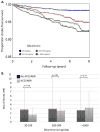Proteinuria, but Not eGFR, Predicts Stroke Risk in Chronic Kidney Disease: Chronic Renal Insufficiency Cohort Study
- PMID: 26130097
- PMCID: PMC4519405
- DOI: 10.1161/STROKEAHA.115.009861
Proteinuria, but Not eGFR, Predicts Stroke Risk in Chronic Kidney Disease: Chronic Renal Insufficiency Cohort Study
Abstract
Background and purpose: Chronic kidney disease is associated with an increased risk of cardiovascular events. However, the impact of chronic kidney disease on cerebrovascular disease is less well understood. We hypothesized that renal function severity would be predictive of stroke risk, independent of other vascular risk factors.
Methods: The study population included 3939 subjects enrolled in the Chronic Renal Insufficiency Cohort (CRIC) study, a prospective observational cohort. Stroke events were reported by participants and adjudicated by 2 vascular neurologists. Cox proportional hazard models were used to compare measures of baseline renal function with stroke events. Multivariable analysis was performed to adjust for key covariates.
Results: In 3939 subjects, 143 new stroke events (0.62 events per 100 person-years) occurred over a mean follow-up of 6.4 years. Stroke risk was increased in subjects who had worse baseline measurements of renal function (estimated glomerular filtration rate and total proteinuria or albuminuria). When adjusted for variables known to influence stroke risk, total proteinuria or albuminuria, but not estimated glomerular filtration rate, were associated with an increased risk of stroke. Treatment with blockers of the renin-angiotensin system did not decrease stroke risk in individuals with albuminuria.
Conclusions: Proteinuria and albuminuria are better predictors of stroke risk in patients with chronic kidney disease than estimated glomerular filtration rate. The impact of therapies targeting proteinuria/albuminuria in individuals with chronic kidney disease on stroke prevention warrants further investigation.
Keywords: albuminuria; kidney diseases; proteinuria; risk factors; stroke.
© 2015 American Heart Association, Inc.
Conflict of interest statement
None of the authors report any financial conflict with the content of this manuscript. Dr. Jaar has received an honorarium from UpToDate for an unrelated medical chapter.
Figures
Comment in
-
Response to Letter Regarding Article, "Proteinuria, but Not eGFR, Predicts Stroke Risk in Chronic Kidney Disease: Chronic Renal Insufficiency Cohort Study".Stroke. 2015 Nov;46(11):e240. doi: 10.1161/STROKEAHA.115.011033. Epub 2015 Oct 13. Stroke. 2015. PMID: 26463697 Free PMC article. No abstract available.
-
Letter by Tsuda Regarding Article, "Proteinuria, but Not eGFR, Predicts Stroke Risk in Chronic Kidney Disease: Chronic Renal Insufficiency Cohort Study".Stroke. 2015 Nov;46(11):e239. doi: 10.1161/STROKEAHA.115.011018. Epub 2015 Oct 13. Stroke. 2015. PMID: 26463699 No abstract available.
References
-
- National Kidney Disease Foundation. K/DOQI Clinical practice guidelines for chronic kidney disease. Part 4: Definition and classification of stages of chronic kidney disease. Am J Kidney Dis. 2002;39:S46–S75.
-
- Levey AS, Coresh J. Chronic kidney disease. Lancet. 2012;379:165–180. - PubMed
-
- Go AS, Chertow GM, Fan D, McCulloch CE, Hsu C-Y. Chronic kidney disease and the risks of death, cardiovascular events, and hospitalization. N Engl J Med. 2004;351:1296–1305. - PubMed
-
- Ninomiya T, Perkovic V, Verdon C, Barzi F, Cass A, Gallagher M, et al. Proteinuria and stroke: a meta-analysis of cohort studies. Am J Kidney Dis. 2009;53:417–425. - PubMed
-
- Abramson JL, Jurkovitz CT, Vaccarino V, Weintraub WS, McClellan W. Chronic kidney disease, anemia, and incident stroke in a middle-aged, community-based population: the ARIC Study. Kidney Int. 2003;64:610–615. - PubMed
Publication types
MeSH terms
Grants and funding
- U01 DK061028/DK/NIDDK NIH HHS/United States
- U01DK060963/DK/NIDDK NIH HHS/United States
- U01DK061022/DK/NIDDK NIH HHS/United States
- U01DK060980/DK/NIDDK NIH HHS/United States
- U01DK061028/DK/NIDDK NIH HHS/United States
- U01DK060902/DK/NIDDK NIH HHS/United States
- M01 RR-16500/RR/NCRR NIH HHS/United States
- U01 DK060984/DK/NIDDK NIH HHS/United States
- U01 DK061021/DK/NIDDK NIH HHS/United States
- P30 GM103337/GM/NIGMS NIH HHS/United States
- U01 DK060980/DK/NIDDK NIH HHS/United States
- U01 DK060963/DK/NIDDK NIH HHS/United States
- UL1 TR-000424/TR/NCATS NIH HHS/United States
- U01 DK061022/DK/NIDDK NIH HHS/United States
- U01DK061021/DK/NIDDK NIH HHS/United States
- U01DK060984/DK/NIDDK NIH HHS/United States
- U01DK060990/DK/NIDDK NIH HHS/United States
- UL1 TR000003/TR/NCATS NIH HHS/United States
- UL1TR000003/TR/NCATS NIH HHS/United States
- UL1 TR000439/TR/NCATS NIH HHS/United States
- UL1 TR000424/TR/NCATS NIH HHS/United States
- M01 RR016500/RR/NCRR NIH HHS/United States
- U01 DK060902/DK/NIDDK NIH HHS/United States
- U01 DK060990/DK/NIDDK NIH HHS/United States
- UL1TR000439/TR/NCATS NIH HHS/United States
LinkOut - more resources
Full Text Sources
Medical
Research Materials
Miscellaneous


